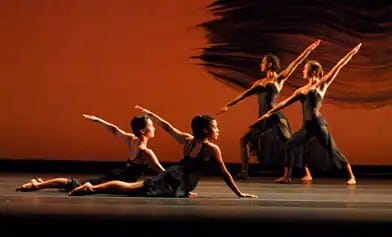- Gathering Note
- Posts
- The Mark Morris Dance Group Returned to the Paramount Friday Night for a Trilogy of Dances, all set to Mozart
The Mark Morris Dance Group Returned to the Paramount Friday Night for a Trilogy of Dances, all set to Mozart

When the Mark Morris Dance Group first performed in Seattle, in the 1980’s, it was in On the Boards’ tiny space in Central District. Since then, the company has performed in nearly every venue in which dance performances are possible. Now, when the company is composed of approximately 20 dancers accompanied by a good-sized orchestra, even the medium-size theater is too small to make the enterprise financially feasible.
Thus, the Paramount Theatre last year and the Paramount again this weekend for the local premiere of Morris’ triple bill of dances, otherwise known as “Mozart Dances.” Morris is at the height of his career and must appreciate the support of his hometown. The trilogy was given its premiere nearly three years ago in New York and has since done some traveling on both sides of the Atlantic.
Not every choreographer is successful in going from a small stage to a major stage. Morris seems to have done so without batting his eyelashes. He is an expert at filling the stage with movement that is often compelling, nearly always musical and constantly in a state of invention.
It is not surprising that Morris responds to Mozart. The choreographer has an innate ability to forge a choreographic response to the music at hand. That instinct did not fail him in “Mozart Dances,” in spite of the essential difficulties of anyone finding an adequate response. It is not an oversight that so few choreographers have avoided Mozart’s music. It is elusive and constantly threatens to subvert the dance itself. And on any number of occasions, in “Mozart Dances,” Morris seemed to get lost momentarily in the midst of all that music, something he rarely does. He is one to command, not to submit.
Morris chose all piano works: two piano concertos (No. 11, K. 413, and No. 27, K. 595) and a duo sonata in D (K. 448.). They were all written within a decade of each other, the last composed in the final year of Mozart’s life. They were suitably titled “Eleven,” “Double” and “Twenty-seven.”
All have their curiosities, in manner and form. Some elicit the raising of an eyebrow and others, a smile. Almost without exception Morris captures our attention. Certain gestures are repeated throughout such as the forced march, or so it seems, and a fall to the ground to conclude a phrase. Sometimes the feet are like bubbles on the floor bouncing about. Then there are the artificial poses in the middle of something otherwise naturalistic.
Even when Morris has to stop to think about what to do, his imagination remains fleet, as does Mozart’s, and so do his dancers. They seem particularly light — men and women — and fast but not necessarily in a bravura sensibility.
“Eleven” has all sorts of fascinating moments, but why do the men leave the stage at the beginning never to return? Then, in “Double,” Morris reverses himself with the men dominating the stage except for a brief, but potent, moment with the women. It is only right that in “Twenty-seven,” men and women join forces in a kind of celebration, with a constant parade of entrances and exits and falls to the floor.
If Mozart’s music is often a beguiling combination of innocence and knowing, so is “Mozart Dances.” On occasion, Morris’ dancers assume an artificial pose of sophistication, only to throw it aside for something else. Nothing lasts very long: Everything is of the moment.
I like Howard Hodgkin decor: white backdrops with a scattering of giant smudges of paint, applied by a brush. They are remarkably effective. Martin Pakledinaz designed the fluid and simple costumes.
Members of the Seattle Symphony were in the pit, so the orchestral playing was especially acute. The conductor, Stefan Asbury, has a long resume, including previous collaborations with the Mark Morris Dance Group. For these performances, first-class pianists were hired. Emanuel Ax was the principal soloist in New York. This weekend it is Garrick Ohlsson. He possesses a crystalline tone and limpid technique, backed by formidable power, so it would be very easy to listen just to him.